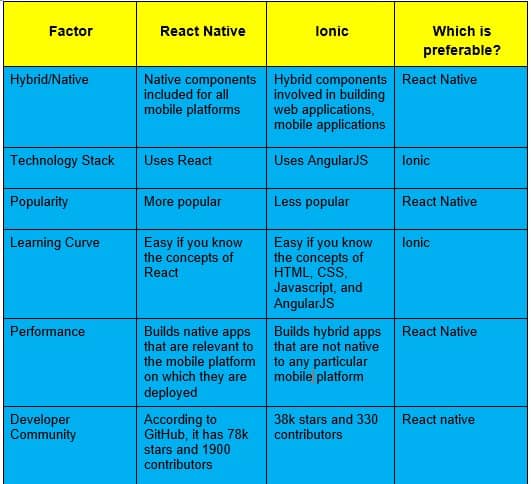
The React Native and Ionic frameworks offer different features. Selecting the best for an application’s development will depend on the application’s properties and requirements.
Starting from VB 6.0 to mobile application development, technology has been emerging at a fast pace in recent years. With modern-day changes, the platforms developing the user interfaces have also become advanced and hence are more automated and more fledged with features and functionalities. Two of such platforms to build user interfaces are React Native and Ionic that are widely used by developers these days. Let us have a look at the basic definition of these two:
React Native: Developed by Facebook, the React Native framework is used to develop the mobile applications for Android and iOS platforms both, under a common syntax to be followed, i.e., Javascript. Hence, the developers can now build dynamic and attractive user interfaces for both the platforms with a single code and hence reducing the efforts of writing separate codes for both.
Ionic: Ionic is an open-source framework that enables its developers to build the dynamic user interface as well as user experience on both- web applications and mobile applications. The framework provides high-end components that can be used to build the best interactive web applications as well as native applications, also known as progressive web apps. Also, it enables you to build the user interface for both Android and iOS platforms.
Having gone through the definitions of these frameworks, let us discuss their features and advantages of deploying them in developing applications so that we can have a clear picture of the differences between the two. All these points are discussed in the upcoming sections.
See also: Why Golang and Not Python? Which Language is Perfect for AI?
Features of React Native framework
The features of the React Native framework are:
1) Write your code once and use it anywhere: The code and the logic built under the react-native framework can be executed anywhere and can be reused in the development of similar applications too.
2) Frequent updates available: As mentioned earlier, the framework is developed and maintained by Facebook. Hence, the quality of the framework is maintained by its hardcore development team, and for this, the team releases frequent updates periodically to ensure the security, inter accessibility, code reusability, etc., advantages in the framework.
3) A larger user community: As the framework is open to all, there are more developers across the globe utilizing it. Hence, if a developer faces any issue in developing the applications, he can easily get support from the other developers using the framework.
4) Supports external libraries: If any functionality needs to be incorporated in the application and is somehow not available with the framework, then the framework allows the integration of the third party or external APIs or libraries to implement that functionality.
5) Architecture similar to React: The architecture of the react-native framework resembles that of the React framework, making it more flexible and scalable for the development team and less complicated whenever any update is introduced in the version of the framework.
Advantages of using React Native:
The advantages of React Native are as follows:
1) It is open-source: Being an open-source framework, as mentioned above, there are a large number of developers working on it, and hence, one can get the solution to any issues faced during the development phase from this community of developers. If you too want your application to be developed on React, you can hire dedicated React Native programmers and let the boat sail.
2) High performance on mobile platforms: The architecture of the React Native framework works well with mobile devices and hence gives high-performance mobile applications. The framework makes use of a Graphical Processing Unit (GPU) to develop the dynamic user interfaces as compared to other native frameworks that are CPU intensive.
3) Live reload feature: This feature of the react-native framework enables you to see the output of the application instantaneously, even after the smallest change in the code. This is displayed in two windows, one that has the code and one that contains the output of it. Hence, you can make a change in the code and immediately observe the changes in the output due to it.
4) Reduces the cost of development: The React Native framework enables the developer to create a common application that can run on Android and iOS. Hence, no need to give efforts, time, and hence the cost of development of two separate applications for each platform.
5) Optimal Performance of the applications: The applications built using React Native can run on all mobile platforms. This means the applications can easily adapt to the mobile environment in which it is run. This gives the optimal performance of the applications in all mobile environments.
Features of Ionic
Having discussed the features and advantages of using the React Native framework, let us have a gist of the same for the Ionic framework. Its features are:
1) It is a cross-platform framework: The applications built on Ionic can be run on varying mobile environments, web browsers, progressive web apps, etc. Hence, we can say it is a cross-platform framework.
2) Based on the web standards: The base of the Ionic framework is built using the standard technologies for web development like HTML, CSS, and Javascript, in addition to the latest APIs. Hence, the APIs included in the framework are considered to be stable, and hence the applications built on them are accepted by multiple platforms.
3) Simple to learn and use: With an HTML, CSS, and Javascript base, the application development becomes easier to learn and implement if the developer has the basic knowledge of the aforementioned scripting languages.
4) Cordova: The Ionic framework contains the plugin named Cordova that allows the single application to run on varying platforms.
5) License: Being an open-source framework, the Ionic framework is registered under MIT. This means that the developer can freely utilize the framework for their commercial and personal projects.
Advantages of using Ionic
The advantages of Ionic are as follows:
1) Easily Adaptable: As mentioned earlier, the base of the Ionic is HTML, CSS, and Javascript. Hence, any developer knowing these three can be efficient in developing applications under Ionic in a very short time.
2) Dynamic User Interface: One can easily customize the components and themes present in the Ionic, making the user interface developed dynamic for the users.
3) The base is AngularJS: The AngularJS, as a base for the Ionic, has resulted in the robustness of the framework, and hence easy to manage applications can be built.
4) Multiple platforms supported: As mentioned in the definition, the framework develops user interfaces that work on a web browser as well as varying mobile platforms.
Comparing both the frameworks: Which one wins?
Let us discuss some factors of the development of an application and which framework fits into it from the following table:

Conclusion
From the above analysis, we can say that if there is a requirement for a mobile application that can run natively on different platforms, React Native is the best option. On the other hand, Ionic can be used if there is a requirement for an application that is compatible with web browsers and mobile platforms.



























